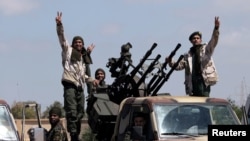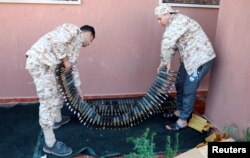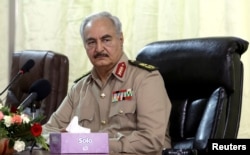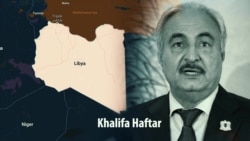As conflict continues to escalate between the forces of Gen. Khalifa Haftar and the United Nations-recognized government in the capital of Tripoli, experts warn Islamic State militants could take advantage of the security vacuum and resurface on the battlefields of Libya.
The unrest in Libya flared up last week when rebel leader Haftar ordered the Libyan National Army from the east to move on Tripoli in a “victorious march” against the Government of National Accord (GNA).
Haftar’s forces have since conducted multiple airstrikes, including on Tripoli’s Mitiga airport, as clashes continue near the gates of the capital.
According to the World Health Organization, the fighting over the past three days has cost at least 47 lives, with 181 others injured. The clashes have also displaced more than 2,000 people from their homes.
U.N. children’s agency UNICEF warned that more than a half-million children could be at “direct risk” if the violence lingers.
Meanwhile, experts who watch jihadist movements in Libya say the turmoil near Tripoli and the risk of the country falling into a broader civil war could create a vacuum that IS militants would exploit to re-emerge after their defeat in 2016.
Libya ‘reset’
Jason Pack, founder of Libya Analysis, said the IS group in Libya has been able to “reset,” moving through three phases of recovery, reorganization and re-engagement during the past two years. He said the militant group is now ready to come back stronger and make new territorial gains as Tripoli clashes draw security forces away from other parts of the country.
“I think this current offensive is great for jihadists,” Pack told VOA. “I see IS and jihadism in Libya now on the verge of making a huge breakthrough, just like they did in 2012-2015 after killing (U.S.) Ambassador J. Christopher Stevens, and then jihadism flourished in many outlets in Libya.”
The U.S. ambassador was killed in September 2012 when the U.S. mission in Benghazi came under a militant attack by Ansar al-Sharia — an Islamist group whose members mostly pledged allegiance to IS after controlling the city of Sirte in 2015.
IS was cleared from Sirte and other populated areas of Libya by late 2016 in a campaign that took months and considerable aerial support from the U.S.
The group has since withdrawn to isolated desert areas and shifted its tactics from controlling land to guerrilla insurgency.
Through its low-level attacks on Libyan forces and local infrastructure, the group is hoping to use a war of attrition to prevent any future progress in Libyan state-building, Pack said. As such, through low-cost and high-impact attacks, it poses a greater threat to Libyan state-building processes in 2019 than it did in 2016.
IS more recently has increased efforts to target key government institutions, including the 2018 attacks on the Libyan Foreign Ministry, the National Oil Corp. and the High National Electoral Commission. Its low-profile attacks have mostly targeted security forces and local leaders in remote areas.
The group Tuesday claimed responsibility for an attack on al-Fugaha in southeast Tripoli, killing three men, including the town’s local council leader and its security official. The town, under Haftar’s Libyan National Army, suffered another deadly IS attack last October.
“That attack on April 9 shows that already ISIS is able to tactically take advantage of the LNA troops being deployed to for this offensive in the north. It shows what’s likely to happen if this fighting continues, that there will be a vacuum, and IS is perfectly positioned to take advantage of that,” Pack, of Libya Analysis, said.
Lawless environment
Some experts warn that Libya’s southern desert areas are particularly vulnerable to IS re-emergence because of their lawless environment. The vast territory has also served as a safe haven for al-Qaida in the Islamic Maghreb, Boko Haram, and the opposition fighters from Chad, Mali and Sudan.
Haftar’s LNA forces earlier this year launched a large-scale attack on the Fezzan region, which made IS supply networks in the south more complicated.
WATCH: Libyan Strongman Khalifa Haftar
Hady Amr, an expert with the Brookings Institution who served as deputy head for the Middle East at the U.S. Agency for International Development (USAID), said the clashes in Tripoli could easily undo the progress made against the jihadists in the distant areas of the country.
“While militant Islam has proven effective at adaptation, and while religion continues to have an appeal in a scary and rapidly transforming world, it is most likely to be most effective in the far-flung areas of Libya,” Amr told VOA.
“It rises up and seeks to exploit the vacuum created by new developments when other factions are in conflict,” he added.














